Regional Names of Durga Puja: Durga Puja / Durga Pujo
|
Region: West Bengal, Bihar, Uttar Pradesh, Delhi & Madhya Pradesh.
During Durga puja or Durga Pujo (commonly called in West Bengal), the idols of Goddess Durga are worshipped for nine days in beautifully decorated 'pandaals'. It is a public festival. On the tenth day,the 'Visarjan' or immersion of idols in sea waters is performed. During this time, in various parts of India, the 'Ram-Leela' is performed. Ram-Leela is a stage inaction of Ramayana, the story of Lord Rama. Durga puja has come to be associated with a grand exhibition of cultural functions.
In towns and villages, the evenings are replete with jatra, theatre, song, music, dance programmes, sports, physical and cultural competitions etc which everyone is free to attend. Community feasts are held. The immersion ceremony (vijaya), provides an impressive finale.
Regional Names of Durga Puja: Navratri Puja
|
Region: Gujarat, Punjab & Maharashta.
Navratri is a festival of worship, dance and music celebrated over a period of nine nights. Devotees perform the 'devi-sthaapna' in their homes wherein they invite the Goddess and perform 'pooja-path' for nine days. Gujaratis perform their traditional dances 'Garba' & 'Dandiya-Raas' during Navratri. The women-folk dance in a circle, singing 'Garbas' or traditional songs.
'Dandiya-Raas' is played with wooden sticks or 'dandiyas'. Apart from Gujrat,Garbas are performed in other states & cities like Mumbai. Young men-women wear colourful traditional dresses and play Garba with great enthusiasm.The mood of Navratri is very colourful & unique.
Regional Names of Durga Puja: Kullu Dussehra
|
Region: Kullu Valley, Himachal Pradesh.
The annual mela or festival takes place in the Kullu Valley - also known as the Valley of the Living Gods, in North India. The festival celebrates the triumph of the God Ram over evil. The Rath Yatra of the idol of Lord Ragunath is led by the Kullu Raja and village deities, and is known as the running of the Gods. The procession starts a week of religious ceremonies, cultural activities, socializing and shopping at the huge bazaar, or market, that comprises most of the mela ground.
Dussehra at Kullu commences on the tenth day of the rising moon, i.e. on 'Vijay Dashmi' day itself and continues in seven days. The birth of Dussehra in Kullu lay in royal fads and it nourished on religious, social and economic factors and ultimately came to be well established, because of the inborn love of the hill-men for fun, frolic, displayed in community singing and dancing. Numerous stalls offer a verity of local wares. This is also the time when the International Folk Festival is celebrated.
Regional Names of Durga Puja: Mysore Dussehra
|
Region: Mysore, Karnataka.
In Mysore, Dussehra is easily the most popular festival. It is celebrated on a grandiose scale here. Elephants are decked up with robes and jewelery and taken in processions through the streets of the city. In fact, many people visit Mysore from all over the country to watch this colorful event. There is also a floating festival in the temple tank at the foot of Chamundi Hill and a procession of chariots around the temple at the top.
The Dussehra of Mysore or Mysore Dassara as it is famously called is a 10-day long festival. On the day of Dussehra, a procession of caparisoned elephants carrying the idol of goddess Chamundi is taken through the city. The festival is celebrated in a grand style with scores of cultural performances in the great Durbar Hall of the Maharaja's Palace. On Vijaydashami, the 10th day of the festival, a colorful procession featuring caparisoned elephants winding through the gaily-decorated streets of the city, mark the occasion.
Regional Names of Durga Puja: Bommai Kolu
|
Region: Tamil Nadu, Karnataka & Andhra Pradesh.
Bommai Kolu is traditionally a women's festival that Tamilians celebrate during Dasshera. Every year, a series of steps is set up and kolu bommai or dolls are displayed. These dolls typically depict gods or village scenes and weddings. A kolu can be as simple or as elaborate as one likes. The woman of the house invites other women to come inspect the kolu, eat a few snacks, exchange a little gossip and go home with a couple of small goodies.
During this time, the girls and women make rounds from house to house during those nine days of Navrathri. Sundal is a delicious confection made from bean sprouts and coconut that is traditionally served at kolu. Women set up decorated planks in a corner and place on it all the dolls in the house. This beautiful clay figurines of gods and goddesses are worshipped during Navaratri, viewing art as Divinity. Women traditionally exchange gifts of coconuts, clothes and sweets.
Regional Names of Durga Puja: Ayudha Puja
|
Region: Tamil Nadu, Kerala, Karnataka & Andhra Pradesh
The ninth day is also the day of the Ayudha Puja. After the slaying of Mahishasura and other demons by Chamundeswari, there was no more use for her weapons. So the weapons were kept aside and worshipped. This Ayudha puja is being celebrated since ancient times. The importance of Ayudha Puja on this occasion may also be due to the fact that on the Vijayadasami day, Arjuna took back his weapons which he had hidden in a Vani tree in order to lead a life in disguise for the promised period of exile. It is believed that one who begins or renovates his learning to work on the Vijayadasami day will secure a grand success as Arjuna did in Kurukshetra war.
The Ayudha Puja is a worship of whatever implements one may use in one's livelihood. On the preceding evening, it is traditional to place these implements on an altar to the Divine. If one can make a conscious effort to see the divine in the tools and objects one uses each day, it will help one to see one's work as an offering to God. It will also help one to maintain constant remembrance of the divine. In India it is customary for one to prostrate before the tools one will use before starting one's work each day; this is an expression of gratitude to God for helping one to fulfil one's duties.
Regional Names of Durga Puja: Vidyaramba
|
Region: Tamil Nadu, Karnataka & Kerala.
The tenth day or Vijayadasami is also the day of Vidyaramba or beginning of study when children usually begin to learn the alphabets. On the Vijayadasami day after a Puja in the morning, the Books and implements are removed from the room and this ceremony is called 'Puja Eduppu'. The time for the break up of the puja marks the beginning of learning and work. Learning and work commence at this auspicious moment.
Literates, in general write the alphabets on sand and read a few sentences from sacred books. Similarly the craftsmen and other skilled workers do some work using their implements. At this auspicious moment the children for the first time are given instructions to write the first few alphabets on rice or sand. They are thus initiated into the world of knowledge. This is called 'Ezhuthinu Iruthu' and according to custom only after this ceremony child becomes entitled to write or read.
Regional Names of Durga Puja: Saraswati Puja
|
Region: Kerala, Karanataka & Tamil Nadu.
The Goddess Saraswathi is worshipped as the Goddess of Learning, the deity of Gayathri, the fountain of fine arts and science, and the symbol of supreme vedantic knowledge. On the Durgashtami day ,a ceremony called Poojavaipu is performed in the evening in Kerala. In a village, generally, it is done only in certain households, in temples and also sometimes in the village schools. The Brahmin houses and the houses which enjoy reputation for learning, mainly take the lead in celebrating the festival. The members of other houses in the village attend the ceremony performed in these houses or institutions.
In a well-decorated room, books and grandhas (holy books) are tastefully arranged with a picture or an image of Goddess Saraswathi in front. In certain poaches weapons and implements are kept by the side of books and garandhas. Then a Puja is performed to Saraswathi during which fruits, beaten rice, roasted paddy (malar), jaggery etc, are offered to Her. These offerings are distributed among those present when the Puja is over.
Just before the Pujavaipu, all studies and work which mainly require skill, are suspended. The following day is known as Mahanavami and it is totally devoted to the worship of Saraswathi. Pooja is performed both in the morning and in the evening. Many more items such as rice, payasam, thirali, etc are also offered to Devi.
The ten-day Saraswati festival, also known as Dussehra or Navaratri, is held September-October. It's celebrated throughout India but takes on special significance in Kerala. Young children are taken to the temples and, before an image of a goddess-celebrated in Kerala as Saraswati, the goddess of wisdom and learning-they are introduced to the letters of the alphabet.
Regional Names of Durga Puja: Simollanghan
|
Region: Maharashtra
In ancient times kings used the feast of Dasara to cross the frontier and fight against their neighboring kingdoms. This border crossing is known as "Simollanghan". Thus Dasara also marks the beginning of the war season.
This was also the day to worship the weapons. According to legend, Pandav went to dwell in the forest. On the way he hid his weapons in the hole of a "shami" tree. After one year he returned from the forest and on Dussehra day he took again his weapons and worshipped the shami tree and the weapons. Hence the custom of worshipping weapons on this feast.
People decorate the entrances of their homes with torans, flower studded strings, and worship the tools of trade, vehicles, machinery, weapons and even books. As the evening falls, the villagers cross the border, and worship the Shami tree. The leaves of the Apta tree are collected and exchanged among friends and relatives as gold.






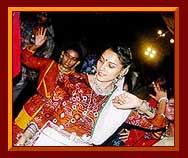
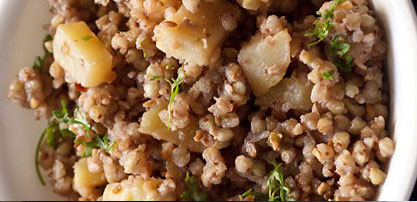
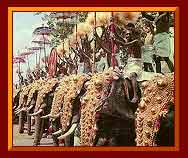
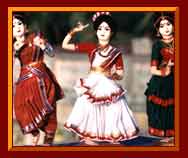
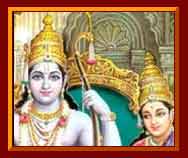
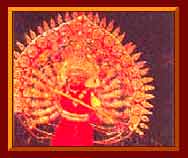
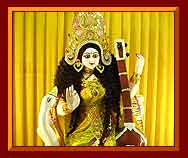

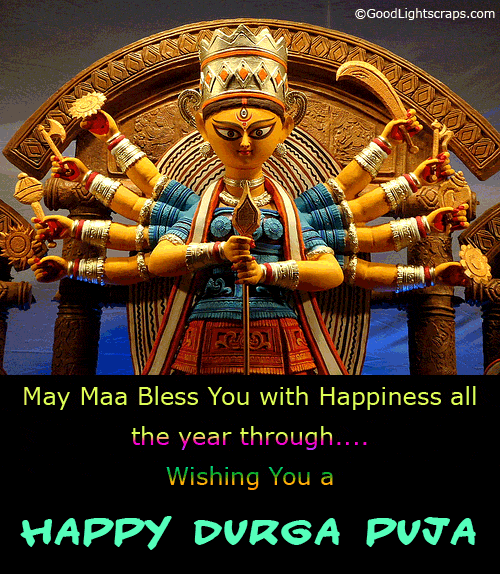
No comments:
Post a Comment